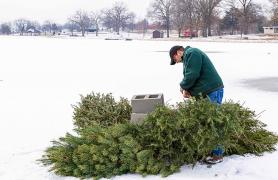The sun’s final rays have flickered below the horizon. Altair, Deneb, and Vega — a triad of jewels — sparkle from the dusky sky. A tiny leg brushes across a stamen, the male reproductive part of a flower. Golden specks with life-generating power adhere to its delicate hairs. Lured by nectar, an insect wings the grains of pollen through the darkness. An encounter occurs at another flower, this time with the female structure, the stigma. This nighttime transfer will propagate a species.
Many know of the essential pollination services our native bees provide. And who hasn’t admired those most glamorous of pollinators, the butterflies? But when it comes to this all-important process, who takes over the night shift?
Scarcely little research has been done on pollination after dark, yet most naturalists and biologists agree that it occurs.
A 2011 experiment by researchers from Nova Scotia’s Dalhousie University measured pollination conducted in enclosures of berry-producing plants. Using netting, researchers made some plants accessible to insects all day and night, some only during the day, and another set only at night. The results showed that nocturnally accessible plants produced about one-third as many ripe berries as the plants accessible by insects for the entire 24 hours. This suggested 33 percent of all pollination occurred after sundown.
Enter the Mighty Moths
When we explore the night pollinators in Missouri, it is the moths — cousins of butterflies — who emerge as the stars under the stars. There are about 160,000 varieties of moths in the world, and most of these are nocturnal. Twelve thousand moth species occur in North America, and they are an extremely diverse group of insects in size, shape, coloring, and habits. Turns out these little moths do the lion’s share of the work.
“They outnumber the butterflies many times,” according to Chris Hartley, entomologist with the Sophia M. Sachs Butterfly House in Chesterfield. “They’re more significant pollinators without a doubt than butterflies because there are more of them.”
A combined study carried out in 2018 by the Universities of York and Hull in the United Kingdom and Australia’s University of Newcastle discovered that moths do indeed spread pollen over large distances during the night.
The research traced pollen carried by moths using cutting-edge pollen DNA detection methods. “Over half of the plant species we detected were not previously known to be visited by moths,” wrote University of York’s Dr. Callum Macgregor, lead author of the study. The research revealed that moths bore pollen from many of the same plant species as bees and butterflies. “Moths appear to complement the work of bees and can carry pollen over greater distances as they don’t have the same ties to a particular part of the landscape,” Macgregor concluded.
Of course, the plants have long-since figured this out for themselves, and some bloom after dark specifically to attract moths. One of the most conspicuous night flowers in this state is the Missouri evening primrose. They produce showy, yellow blossoms up to 5 inches in diameter and are often found on dolomite glades or dry, rocky prairies. This plant relies on moths for its propagation. Its light-colored petals are easier to see at night, and the flowers give off a strong scent in the evening that attracts moths.
“Primrose species we kind of think of being classic night-pollinated flowers,” said MDC Natural History Biologist Steve Buback.
Buback has spent time on Missouri’s northwestern prairies studying another wildflower which takes advantage of night pollinators — the prairie fringed orchid. Like the evening primroses, its flowers are light in color. This endangered grassland plant blooms day and night, but its fragrance becomes stronger after dark to draw in nocturnal hawk moths.
Hawk moths, also known as “hummingbird moths,” come from the sphinx family of moths. Many species of this family inhabit Missouri and are excellent examples of night pollinating moths. They are characterized by thick, robust bodies and zippy flight patterns that mimic the hummingbird. Hawk moths have exceptionally long proboscises, structures they use to draw out nectar from flowers. Their stout, hairy forms are boxcars that transport large loads of pollen.
“In most plants, pollination is a kind of partnership between plant and pollinator,” Hartley said. Numerous plants have structures evolved to get more pollen dusted onto their primary pollinating visitors. The more an insect interacts with a plant, the more pollen rubs off on it. “The plant has ‘rigged’ its nectar reward so that the insect has to run through the pollen to get to it,” said Hartley.
The relationship is mutually beneficial, Hartley stressed. “The pollinator is coming away with a belly full of nectar, so it’s getting a great reward.”
Supporting Players
Moths aren’t the only players in the night pollinating game. Hartley said there’s a lot of compelling evidence that flies are also significant pollinators. “After bees, the consensus is that flies are the world’s second most important pollinators, night and day both,” he said. Flies visit flowers at night seeking nectar as well and spread pollen in the process. In fact, some plants can only be pollinated by flies. With over 150,000 species documented worldwide, flies interact with a tremendous number of plants in the dark of night.
Members of the largest order of insects in the world, the beetles, also participate in nocturnal pollination. For some plants, their services are essential, but for many others, pollination by beetles is more incidental. Yet, considering they make up around 40 percent of all insects worldwide, even when the pollination influence of beetles is accidental, it adds up. Scarab and soldier beetles spend a lot of time in flowers and are among the more effective, Hartley pointed out.
Humans may not appreciate mosquitoes, but nocturnal plants don’t hesitate to court their pollinating favors. Female mosquitoes are the ones that suck blood, using the proteins to produce their eggs. Aside from that, adult mosquitoes are quite content to feast on the ambrosia of flowers during the night as they too carry pollen from plant to plant. It sure seems there are plenty of them out there to do the job.
“If insects are visiting and they’re drinking nectar, then there’s a chance they’re going to transfer pollen from one plant to another,” Buback said of the night pollinating crowd.
An encounter with other random night bugs could occasionally move pollen from plant to plant as well. This is less likely with insects that don’t eat pollen or are not consistent in the plants they visit, such as katydids, but it is still conceivable. There’s evidence to suggest katydids might play a bigger pollinating role in some other ecosystems. Bats perform vital pollination duties in parts of the world, too; however, none of the winged mammals found in the Show-Me-State do so.
Shift Workers
Not all nocturnal pollinating happens at the same time. During the night shift, different species split their duties into distinct “sub shifts.” The nocturne begins an hour or so before and after sunset with the crescendo of the crepuscular crowd, or twilight insects, as they come out to play. While the night progresses, a variety of species bow in and out of the pollination performance; still others dance all night long. It’s a complex symphony orchestrated by changing light levels and other influences yet unknown, all set to the mysterious music of evolution.
Where night pollinating is concerned, there are some insects who are all show and no go. The silk moths are among them, like the eye-catching polyphemus and luna moths. Same goes for the luminous fireflies, a species of beetle. These insects are all much too busy showing off to find mates during their short adult lives. They have little inclination to eat or pollinate and use plants merely as spots to rest from their amorous activities.
Still, that leaves plenty of pollinating to go on after the sun goes down.
Waste No Time
“We as human beings don’t often think about what happens after we go to bed because we are diurnal animals,” Hartley said. “Our biology is to be awake during the day, so we kind of forget about how important everything else is.”
While bees remain the world’s prime pollinators, Buback also feels the “night shift” should not be overlooked. “Some plants have adapted to night pollinators, so they’ve got to be doing some good work out there.”
Think about it. Life on Earth spends half its existence under night. If nature didn’t put all those hours to good use, wouldn’t it be an awful waste of time? Thanks to an army of nocturnal pollinators, a lot can happen under the stars.
Stealing the Night Away
Nocturnal pollinators that depend on darkness to do their work are being robbed of the night. Growing evidence shows excessive artificial light has intrusive and negative effects on our natural ecosystems. Night creatures are being confused, distracted, and disoriented as nights grow ever brighter under manmade illumination. More than just a loss for astronomers and poets, the erasing of the night sky affects natural processes from bird migrations to night pollination.
Who hasn’t seen a group of moths mesmerized around a street lamp? It is believed many night creatures use the moon and stars to help navigate. These distant light sources are relatively fixed visual references, providing constant bearings to follow. By contrast, the closeness of a porchlight mere inches or feet away makes the light’s position appear to constantly change from the moth’s point of view as it flies. The insect is forced to alter course continually trying to keep the light in the same orientation, which launches it into a confused, never-ending orbit.
“What do you think those moths would be doing if they weren’t attracted to that light? They’d probably be out pollinating,” said Hartley. “They’re spending their whole night at these lights instead of out there visiting flowers.”
Here are some things we can all do to help minimize the effects of light pollution:
- Don’t leave porch and yard lights on all night; use lighting only when needed.
- Light just the areas with a real need for light; avoid decorative or landscape lighting.
- Choose lights that are no brighter than required, and try to avoid those with blue emissions.
- Where lights are used, employ fully-shielded fixtures that direct all the light downward where it is truly useful. Scattered light in other directions wastes energy and creates glare, making it harder to see.
- Employ motion-detection lights over constant ones where security is a concern.
- Urge friends and neighbors to do the same, and everyone will save energy costs, too.
With a little enlightenment, we can make it easier for our night shift pollinators to do their indispensable work. For more information, visit The International Dark-Sky Association at DarkSky.org.




























Also In This Issue


And More...
This Issue's Staff
Editor - Angie Daly Morfeld
Associate Editor - Larry Archer
Staff Writer - Bonnie Chasteen
Staff Writer - Heather Feeler
Staff Writer - Kristie Hilgedick
Staff Writer - Joe Jerek
Art Director - Cliff White
Designer - Shawn Carey
Designer - Les Fortenberry
Designer - Marci Porter
Photographer - Noppadol Paothong
Photographer - David Stonner
Circulation - Laura Scheuler






















